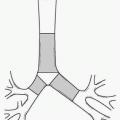Peritoneal Dialysis
Peter B. Hathaway
Peritoneal dialysis (PD) is a form of permanent renal replacement therapy that utilizes the semipermeable properties of the peritoneal membrane to remove excess metabolic solutes and fluid. PD requires the implantation of a catheter into the peritoneal space to facilitate filling and drainage of a dextrose- and electrolytecontaining fluid, termed dialysate. Efficient PD requires near-complete drainage of indwelling dialysate with each fluid exchange. Meticulous attention to catheter site planning and procedural detail can improve outcomes by optimizing catheter performance and reducing the risk of treatment failure.
Absolute
1. Documented loss of peritoneal membrane function
2. Extensive peritoneal adhesions (“frozen abdomen”)
3. Patient who is physically or mentally incapable of performing PD
4. Uncorrectable hernias or body wall defects
5. Women starting the third trimester of pregnancy
Relative
1. Fresh intra-abdominal foreign bodies
2. Peritoneal leaks
3. Body size limitations
4. Intolerance to PD volumes
5. Inflammatory or ischemic bowel disease
6. Active abdominal wall or skin infections
7. Morbid obesity (in short individuals)
8. Severe malnutrition
9. Ostomy
10. Frequent episodes of diverticulitis
11. Homelessness
Preprocedure Preparation
1. Clinical evaluation is recommended prior to elective PD catheter placement. Examine the abdomen with the patient both supine and upright to locate the catheter exit site away from skin folds or the belt line.
2. Preprocedural imaging is not generally needed.
3. Anticoagulants and antiplatelet medications are stopped for an appropriate interval prior to the procedure. International normalized ratio (INR) < 1.5 recommended (4).
4. A bowel preparation is recommended if there is a history of constipation.
5. The patient should empty their bladder before entering the procedure area.
Procedure (5)
1. Prophylactic antibiotics. A single dose of intravenous (IV) cephalosporin, or vancomycin if cephalosporin-allergic, is given.
2. Preoperative site marking
a. Careful site planning is recommended to ensure proper catheter placement.
b. PD catheters are most often placed to the left of midline. Placement opposite the site of dominant surgical scars may help to avoid adhesions.






